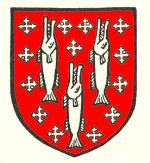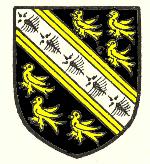Woodcroft alias Halyards Manor Luton
Luton possessed, at various times twenty five manors. The histories of all these manors are given in the Victoria County History for Bedfordshire, published in 1908 and due to be updated early in the 21st century.
Woodcroft alias Halyards Manor was the result of dividing the medieval Manor of Luton into six parts on the death of Isabel de Clare, wife of William Ferrers, Earl of Derby in 1275 - one share going to each of her daughters. Woodcroft alias Halyards was the share of Sybil de Bohun but was not known by the name until a little later.

Lucy coat of arms
Almost as soon as his mother inherited her sixth of Luton Manor, Sybil's son John de Bohun transferred it to Emery de Lucy who died before the end of the thirteenth century and was succeeded by Geoffrey de Lucy, who died in 1305 owning "one sixth of the Manor of Luton, namely the hamlet of Woodcroft". His son, also Geoffrey died in 1346 and was succeeded by yet another Geoffrey, who was followed by his son Reginald in 1400. Reginald died in 1347 and was succeeded by his son Walter, who died in 1444 leaving his son William as his heir. William died in 1461 and the manor passed to his widow Margaret and on her death in 1467 it was divided between William's niece Elizabeth, wife of John, Earl of Worcester and nephew William Vaux. Vaux at some point reunited the two halves of the manor but was killed at the Battle of Tewkesbury in 1471.

Wingate coat of arms
The manor stayed in the Vaux family until sold by Sir Thomas Vaux, Lord Harrowden [the Harrowden in Northamptonshire rather than the hamlet of Eastcotts], courtier and poet, to Walter Devereux, 1st Earl of Essex who, in 1544, conveyed it to trustees. At some point the manor was sold, as by the 17th century it was held by a Ralph Alwey, who died in 1623 and devised it to his three daughters Mary, Anne and Dorothy. The manor eventually ended up as Mary's portion on her wedding to Edward Wingate who also acquired Woodcroft Manor. In 1653 Wingate conveyed both the Woodcroft manors to Robert Napier, effectively reuniting it with the other four sixths of the medieval Manor of Luton, though both manors maintained a separate identity, although in the same ownership. However, a succession of Law of Property Acts in the 1920s effectively abolished manors in all but name. including copyhold land and manorial courts and income

Napier coat of arms